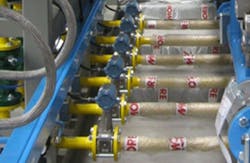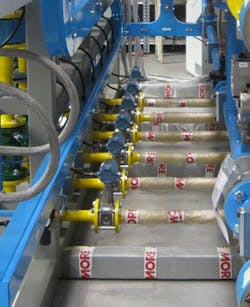Application Note: Vortex Flow Meters Help Steel Maker Save Energy
MORE s.r.l. has reduced energy consumption and optimized the quality of steel produced from its electric arc furnaces by using Rosemount 8800 Vortex flow meters from Emerson Process Management. The flow meters are being used to more accurately measure and optimize oxygen used in the steel making processes. Optimization of the oxygen-fuel ratio is critical to minimizing conversion costs, reducing oxygen and fuel consumption, and avoiding rework. In addition, the vortex flow meters provide accurate control of oxygen to improve furnace safety and reduce environmental impact.
Based in Gemona del Friuli (UD), Italy, MORE supplies a wide range of technologies and auxiliary equipment for electric arc furnaces used in the steel-making industry. These include sidewall injector systems used with chemical energy packages such as oxygen, carbonaceous fuels, lime, and other fines. These chemicals are injected into the furnace during the manufacturing process to improve steel quality and provide additional energy from exothermic reactions, helping to reduce overall energy consumption.
MORE had been using differential-pressure (DP) flow meters to measure the oxygen flow in its electric arc furnaces. However, the capabilities of the existing meters made it difficult to meet customer demand for even more accurate control, as well as changing process requirements. More accurate instruments with a broader measurement range were required.
MORE decided to evaluate vortex flow meters.
Considering Vortex Flow Meters
“We tried vortex meters from various other manufacturers but found that their products were not sturdy enough, or they were too sensitive to vibrations that resulted in an unreliable measurement and consequently, poor control of the oxygen-fuel ratio,” said Roberto Urbani Purchasing Manager, MORE s.r.l., in a prepared statement. “Using Rosemount vortex flowmeters eliminated these problems–delivering the accurate and reliable measurements we required.”
Emerson’s Rosemount 8800 vortex flow meters feature a design that addresses the limitations of traditional vortex flow meters. Its signal filtering (Adaptive Digital Signal Processing-ADSP) and a mass-balanced sensor design maximize measurement reliability and eliminate the impact of vibrations on measurement accuracy.
In addition, to meet customer demands for greater flexibility in their furnace installations, the 25-to-1 rangeability of the 8800 helps to optimize gas heaters, providing greater opportunities to vary the characteristics of the steel for different applications. And while DP flow meters can have up to 30 leakage points, the gasket-free sensor design of the 8800 means there are no potential leak points, reducing maintenance requirements and enhancing safety, Emerson says. The unique meter body design eliminates all ports and crevices that can affect the ability of the sensor to measure flow, and the isolated sensor design eliminates the need to break process seals for sensor replacement.
“By implementing Emerson’s Rosemount vortex technology, we have been able to build electric arc furnace solutions that guarantee optimum furnace efficiency for users,” Urbani said. “MORE and its users have been able to optimize furnace efficiency in terms of productivity and steel quality. Over-oxidation is no longer an immediate concern, extending the furnace life cycle. Energy consumption and ambient pollution have also been reduced.”
The accurate measurement of oxygen is critical in the steelmaking process. Too much oxygen causes over-oxidation (decarburization), which requires expensive re-work to obtain steel of suitable quality. It also creates over-heating, which can damage the furnace. Too little oxygen, on the other hand, slows production. The application therefore demands measurement devices that enable accurate control of the injector feed oxygen-fuel ratio.
Over the past decade, MORE has installed more than 1000 Rosemount 8800 Vortex flow meters across many of its furnace installations and has experienced optimum performance (+99 percent reliability). This has contributed directly to the Overall Equipment Efficiency of the furnace.



